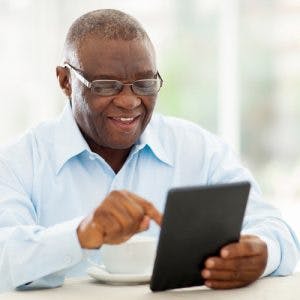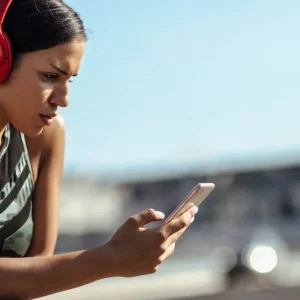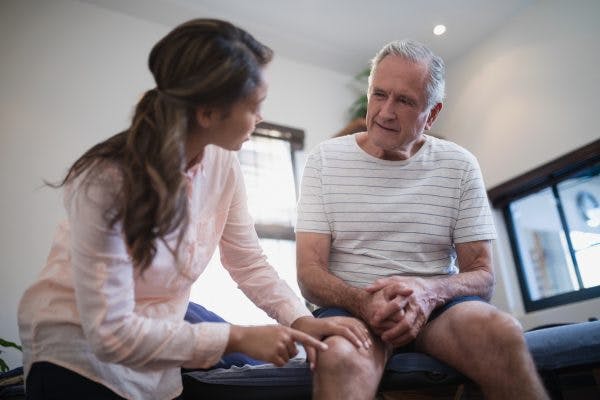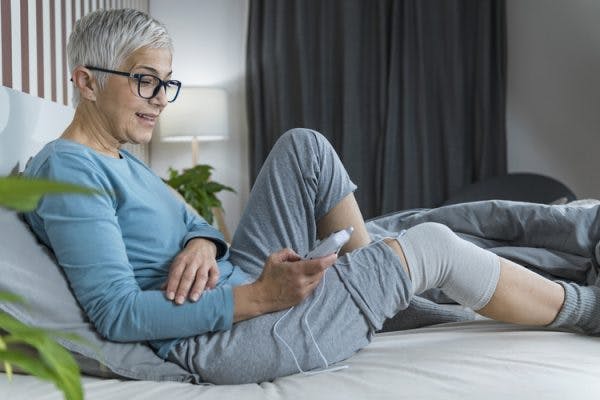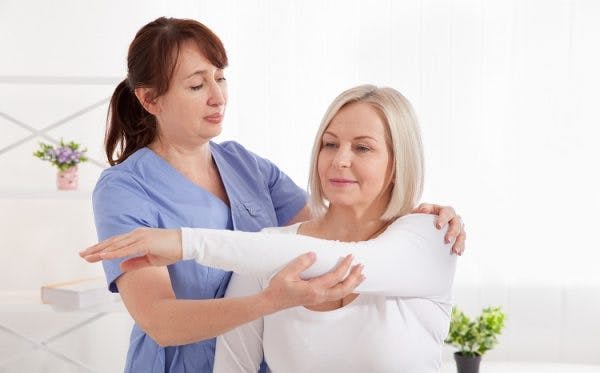Numbness after stroke is a common secondary effect that involves the loss of sensation in affected areas. This effect can be complex and is often accompanied by other sensory issues. These can include pain, tingling sensations, and even hypersensitivity.
For some survivors, post-stroke numbness goes away on its own through the phenomenon of spontaneous recovery, which we will discuss later. However, other survivors may experience lasting numbness due to their stroke. For those who experience lingering numbness, specific rehabilitation methods can be utilized to promote the return of sensation after stroke.
To help you get started, let’s begin by discussing the causes and details of numbness after stroke. Then we will review the different treatments available, the rehabilitation process, and more about the stroke recovery timeline.
What Causes Numbness After Stroke?
To understand numbness after stroke, it can be helpful to review how a stroke affects the body. A stroke occurs when blood flow in the brain becomes disrupted, either due to ischemic stroke or hemorrhagic stroke. When brain cells become deprived of oxygen-rich blood, they begin to die. The result is tissue damage in the affected areas of the brain, causing those areas to lose their important functions.
The area of the brain affected by stroke determines the secondary effects that occur. For example, if an area of the brain that helps regulate sensation is affected, this may result in numbness or other sensory impairments. Regarding post-stroke numbness, three areas of the brain deserve a deeper look: the thalamus, the parietal lobe, and the occipital lobe.
- Thalamus: This area is responsible for relaying the majority of sensory input in the brain.
- Parietal Lobe: This area of the brain houses the somatosensory cortex. Additionally, the parietal lobe receives and processes sensory information from the sensory nerves.
- Occipital Lobe: In a related manner, the occipital lobe differentiates this input from the five senses, including touch.
Therefore, post-stroke numbness is commonly seen after thalamic stroke, parietal lobe stroke, or occipital lobe stroke because these areas of the brain play a large role in sensory function. Even if a stroke does not impact these areas, numbness can still occur. Additionally, the brain may misinterpret sensory signals after stroke, which can lead to hypersensitivity and other abnormal sensory responses.
If you struggle with any sensory issues, it is important to seek advice from your therapy team. Furthermore, if you are experiencing a new or sudden onset of numbness or tingling, this may be a sign of a medical emergency. Familiarize yourself with the different stroke warning signs and get immediate medical help if you or a loved one are experiencing these symptoms. In addition to facial drooping, weakness of the limbs, or speech difficulties, the sudden onset of numbness can indicate that a stroke is occurring.
How Long Does Numbness Last After Stroke?
Since every stroke is different, everyone will recover at different rates. For example, some stroke survivors may experience spontaneous recovery where sensation returns on its own. Spontaneous recovery refers to the rapid improvement of stroke secondary effects and return of function. If this happens, it usually occurs within the first few months of recovery.
However, if sensation does not return on its own, then rehabilitation should be pursued to help survivors improve numbness after stroke. The amount of time it takes to recover sensation depends on factors unique to every person. This includes the location of the stroke and the intensity of rehabilitation.
The intensity of rehabilitation has a particular impact on recovery from the effects of stroke. Studies have shown that stroke patients recover rapidly during the first few months but may remain at this level even at the 5-year mark if rehabilitation is not continued. Researchers theorize that the intensity of inpatient rehabilitation and lack of post-acute care are to blame for this unfortunate statistic.
This does not mean that patients cannot improve numbness after stroke even if it has been longer than 3 months. Instead, it means that rehabilitation should be pursued well after the 3-month mark to maximize recovery. Even when neurological recovery has slowed, functional recovery can continue for a lifetime. There are several treatments available to help combat numbness after stroke, which we will review in the next section.
Want 25 pages of stroke recovery exercises in a PDF? Click here to download our free Stroke Rehab Exercise ebook now (link opens a pop up for uninterrupted reading)
Treatment Methods for Numbness After Stroke
There are a variety of different rehabilitation methods available to promote the return of sensation after stroke. You can pursue some of these at home on your own, although others will require the help of your therapy team. By participating in treatment and rehabilitation for post-stroke numbness, you can maximize your chances of sensation returning to the affected areas.
The different treatments we will review depend heavily on the concept of neuroplasticity. This refers to the brain’s natural ability to reorganize itself and learn new functions. Through neuroplasticity, functions in areas of the brain that were damaged can be rewired to healthy, unaffected areas. With time, this allows your brain to become more efficient in carrying out these functions.
Neuroplasticity is best activated through the dedicated practice of rehabilitation exercises. High repetition, or massed practice, can help the brain make neural connections stronger and more efficient. Gradually, survivors can begin to see improvement in stroke secondary effects, including numbness or other sensory changes. To help you get started, here are the best rehabilitation methods for numbness after stroke:
1. Sensory Retraining Exercises
Post-stroke numbness is different from other types of numbness because the issues originate from the brain, not the local tissue. Therefore, the most popular way of treating numbness is through sensory retraining, also called sensory reeducation. Sensory retraining seeks to teach the brain how to interpret your senses by practicing different exercises involving touch.
For example, you can gather objects of different textures (like rough sandpaper, fluffy cotton balls, silk, etc.) and feel them without looking. Then, look at the object to provide yourself with visual feedback. Another example of a sensory retraining exercise is practicing temperature differentiation. This involves alternating between touching warm and cold objects to help retrain sensory pathways.
Although sensory retraining exercises can be exceptionally difficult initially (especially if there is no sensation), the goal is to slowly rewire the brain through repetitive stimulus. Your physical therapist or occupational therapist can provide more information about sensory retraining exercises to improve numbness or other sensory impairments.
Learn more about sensory retraining after stroke »
2. Electrical Stimulation
Some types of numbness after stroke can benefit from the use of electrical stimulation, or e-stim. For example, survivors with neuropathy after stroke or central post-stroke pain can experience improvement in numbness and pain by using electrical stimulation.
E-stim provides gentle stimulation to the nerves and muscles and can help engage neural pathways between the brain and limbs. This has been shown to help reduce painful symptoms, which can subsequently improve quality of life.
If you are interested in trying electrical stimulation, talk with your therapy team. There are certain conditions that can make e-stim unsuitable for some individuals. Additionally, it can be dangerous to try electrical stimulation if you have decreased sensation. For this reason, consult your therapist to help you get started with this treatment.
3. Electroacupuncture
Acupuncture is an alternative treatment that involves inserting thin needles into specific acupoints on the body. Sometimes electrical stimulation is applied to the needles after insertion, which is called electroacupuncture.
Studies have shown that electroacupuncture helps encourage neuroplasticity in stroke patients with somatosensory effects, such as numbness. The study we’ve linked noted that patients showed greater response to tactile stimulation (like sensory retraining exercises) than electroacupuncture, but both enhanced neuroplasticity and recovery from stroke.
Learn more about acupuncture for stroke recovery »
4. Mirror Therapy
Mirror therapy is commonly used to promote motor recovery in the hand after a stroke, especially when hand movement is severely affected. This makes it a great rehabilitation method for post-stroke hand paralysis. Furthermore, mirror therapy has been shown to improve sensation after stroke and can also help manage painful symptoms.
This treatment involves placing a tabletop mirror over the survivor’s affected hand. Then, the survivor practices various hand therapy exercises with their unaffected hand while watching their reflection. This helps activate mirror neurons in the brain and encourages neuroplasticity. With time, survivors may notice an improvement in numbness and hand function as neural pathways become stronger.
Learn more about mirror therapy »
A Note on Safety and the Importance of Rehabilitation
Treatment for numbness after stroke should be taken seriously because the inability to feel poses certain risks. For example, cooking can be difficult and dangerous when you cannot feel your affected arm. If you aren’t paying close attention, you run the risk of accidentally brushing up against the stove or a boiling pot and burning yourself without realizing it.
Getting dressed provides another example. If you cannot feel your affected leg or foot, you run the risk of fastening your shoe too tightly. In turn, this can lead to abrasions or wounds and poses an infection risk. Therefore, if you struggle with numbness after stroke, it’s important to be cautious of your affected side at all times.
Seek help from an occupational therapist who can help you get started with sensory retraining and encourage the return of sensation after stroke. They can also provide different tips and techniques to maximize your safety as you perform your activities of daily living.
Recovering Sensation After Stroke
Numbness after stroke occurs when the brain cannot correctly process sensory input from the skin and the environment. This is not caused by issues with the skin itself, but rather by changes in the brain’s ability to process sensory information. This happens when a stroke causes damage to the areas of the brain responsible for sensation, such as the thalamus, parietal lobe, and occipital lobe.
Sometimes sensation returns on its own through spontaneous recovery, generally returning in the first 3-6 months after injury. Other times, rehabilitation is required to boost neuroplasticity and retrain the brain to process sensory information. This can help improve your sense of touch and can also be used to reduce other sensory issues such as hypersensitivity.
Some helpful rehabilitation methods include sensory retraining exercises, mirror therapy, electrical stimulation, and even electroacupuncture. Ask your therapist to help you get started with sensory retraining to help reverse numbness after stroke. You can also ask for tips to improve your safety during daily activities.
Whether or not you experience spontaneous recovery, your chances of improving your numbness after stroke increase when you take action. Practicing consistent rehabilitation techniques can help you improve your independence with daily tasks and can reduce the secondary effects of your stroke. We hope this article has helped explain numbness after stroke and can encourage you to continue pursuing your unique recovery goals.




